Like their cousins the U.S. national parks, National Wildlife Refuges in Florida are preserved because they are exceptional places.
Unlike the national parks, however, wildlife refuges have a low profile. They’re sometimes called America’s best kept secret.
Florida has so many refuges – 29, the third most in the country (after California and North Dakota) — that there’s one in every corner of the state.
Some of my favorite places are National Wildlife Refuges in Florida – places where you can see flocks of birds, manatees, alligators, turtle nests, Key deer, historic lighthouses and wondrous scenery.

Florida is also home to the nation’s first wildlife refuge, Pelican Island Wildlife Refuge, established in 1903 by President Theodore Roosevelt to protect great egrets and other birds from plume hunters. (Compared to some national wildlife refuges, it’s tiny — a three-acre island and 2.5 miles of surrounding waterway in the Indian River Lagoon.)
Here are eight favorite national wildlife refuges in Florida that make an excellent addition to your Florida travels, especially in winter when these refuges are filled with migrating birds.
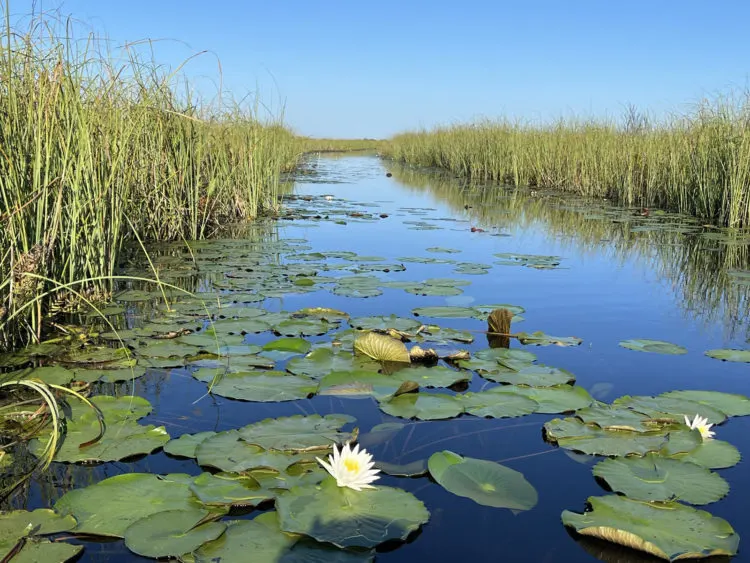
Loxahatchee National Wildlife Refuge, Palm Beach County
Arthur R. Marshall Loxahatchee National Wildlife Refuge, whose headquarters are in Boynton Beach, is a huge (226 square miles) sprawling swath of Northern Everglades. One thing that makes this wildlife refuge so special is that 6 million people in very urban South Florida live within 90 minutes of all this wildness. So if you visit Miami-Dade, Broward or Palm Beach counties, this wildlife refuge is within 60 to 90 minutes of a drive.
Loxahatchee NWR (which is NOT the same as the Loxahatchee River in Jupiter) has four key features for visitors:
- A 5.5 mile canoe/kayak trail through the Everglades. You can rent kayaks and canoes on site.
- An exquisite half-mile boardwalk though a cypress forest, part of the largest cypress forest left on the east side of the Everglades. (Imagine: This forest once extended uninterrupted from Lake Okeechobee to Fort Lauderdale.)
- Trails around a network of water impoundments providing outstanding birding in the winter.
- A multi-use trail on the levee that is excellent for riding fat-tire bicycles or hiking.
Loxahatchee National Wildlife Refuge Visitor Center
Lee Road, Boynton Beach, FL, 33473
(Two miles south of Boynton Beach Blvd on Route 441. Look for the turn at Bedner’s Farm.)
Florida Rambler with more on Loxahatchee National Wildlife Refuge
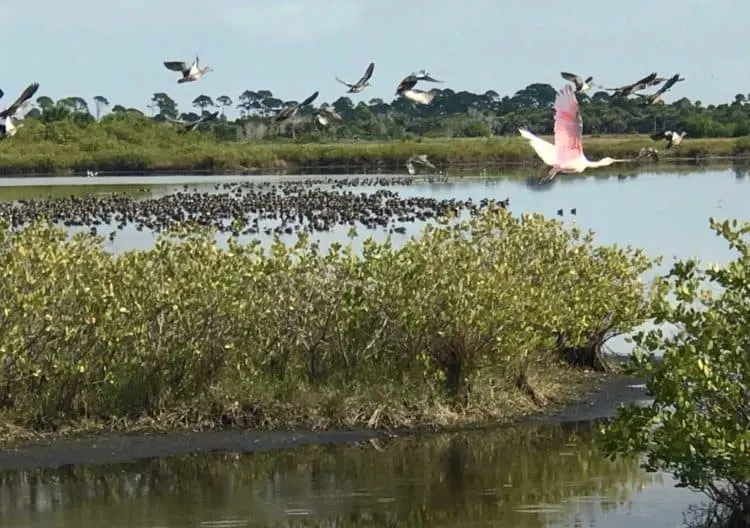
Merritt Island National Wildlife Refuge, Titusville
The 140,000 acre Merritt Island National Wildlife Refuge is one of the best places in Florida to see birds in the winter, plus it offers boating, hiking and much natural beauty.
The go-to spot is Blackpoint Wildlife Drive, a 7.7 mile long, one-way one-lane dirt road through areas of the refuge where the water level is managed to benefit wildlife. A visit here in winter is sure to reward nature lovers.
In one magical day here in 2022, I saw a bald eagle in a tree, a group of roseate spoonbills flying past hundreds of ducks, geese and heron in the water, and then, on a quiet trail we had all to ourselves, several beautiful not-at-all shy scrub jay up close.
Concentrations of waterfowl here often exceed 100,000 birds in the winter months!
There’s more: It’s a good place to see manatees (in the summer), there is excellent boating and kayaking (no rentals; bring your own boat) and several hiking trails.
Merritt Island National Wildlife Refuge
Scrub Jay Way #32782, Titusville, FL
(321) 861-0669
Florida Rambler with more about Merritt Island National Wildlife Refuge
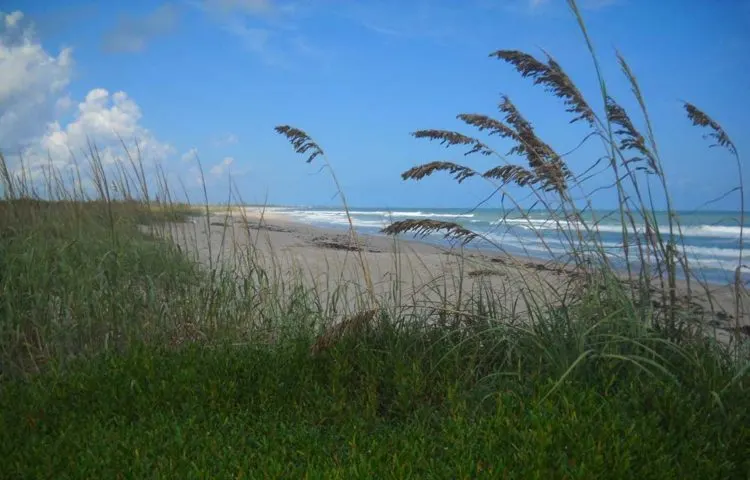
Nathaniel P. Reed Hobe Sound National Wildlife Refuge, Hobe Sound
When I say “best kept secrets,” Hobe Sound National Wildlife Refuge is exactly what I’m talking about.
The refuge has property on both sides of the Indian River Lagoon separated by about five miles. We stumbled on the beach portion of the Hobe Sound NWR when we were bicycling on Jupiter Island. We were pedaling north on the beautiful two-lane road, Beach Road. When the road ended, we discovered a magnificent wild beach that is part of the Hobe Sound National Wildlife Refuge.
The Hobe Sound NWR beach has no signage tipping you off; it has a simple parking lot and then more than five miles of wild, pristine sandy shore, lined with thick native vegetation and without a condo in sight. Hobe Sound NWR is the longest undeveloped beach in South Florida. Here’s a Florida Rambler story about the Hobe Sound NWR beach.
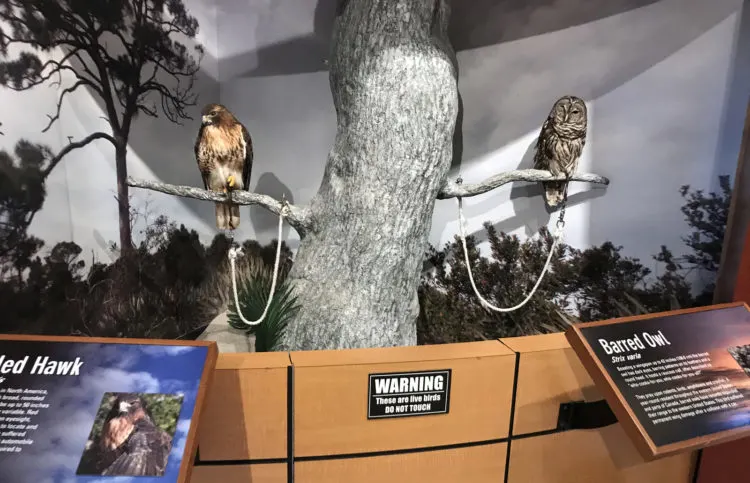
The other parcel is at the headquarters of the Hobe Sound National Wildlife Refuge, where you’ll find a free nature center. It’s small but one of those hidden gems you like to discover, especially if you’re traveling with kids or like animals.
It’s an educational outreach program with a small collection of animals that have been rehabilitated but cannot go back into the wild.
When I entered the exhibit, I admired the taxidermy display of two birds, a red tailed hawk and a barred owl. And then the hawk blinked, and I realized they were both very much alive. The birds have lived here for 20 years and are used to visit schools and educational programs.
Tanks contain interesting native species, including baby alligators, a spotted skunk, common Florida snakes and more.
Adults may spend 20 minutes looking at the animals, I suspect kids would be entertained for much longer.
I also recommend the very short loop nature trail behind the nature center. The trail traverses a surprisingly hilly area, almost mountainous by Florida standards. The trail is blinding white sand formed by ancient dunes. It eventually leads down to a pretty little sandy beach on the clear water of the Intracoastal Waterway.
Hobe Sound Nature Center
13640 SE Federal Highway, Hobe Sound, FL 33455
(772) 546-2067. Closed Sundays.
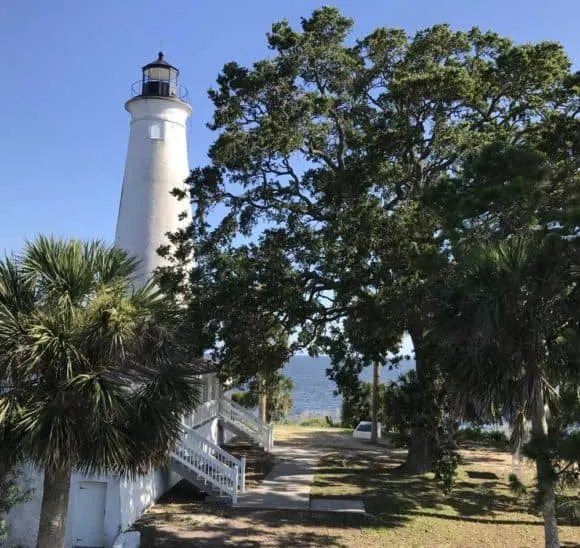
St. Marks National Wildlife Refuge, St. Marks
St. Marks National Wildlife Refuge is a vast place where visitors see birds, wildlife and a historic lighthouse. It’s a hidden gem in the Big Bend region.
As you explore the refuge, watch for wildlife big and small: Friends of the St. Marks Wildlife Refuge has built a list of 38 species of amphibians, 69 species of reptiles and 44 species of mammals seen in the refuge. In winter when migratory birds fills the ponds and shore, this is heaven for birders. Some 250 species occur annually; 350 species have been recorded overall.
Stop at the refuge headquarters, where there’s a one-third-mile boardwalk trail around a pretty freshwater pond. Then take the road to the 1831 lighthouse, which passes extensive wetlands where you’ll see fishermen trying their luck, and there are plenty of places to enjoy the views. The road ends at the scenic St. Marks lighthouse, where you can walk along the half-mile-long Lighthouse Levee Trail admiring the grassy coastline.
St. Marks Refuge can also be part of a terrific drive on the Big Bend Scenic Byway, about which we have an extensive article.
St. Marks National Wildlife Refuge
1255 Lighthouse Road
St. Marks 32355
(850) 925-6121
Florida Rambler with more on St. Marks National Wildlife Refuge
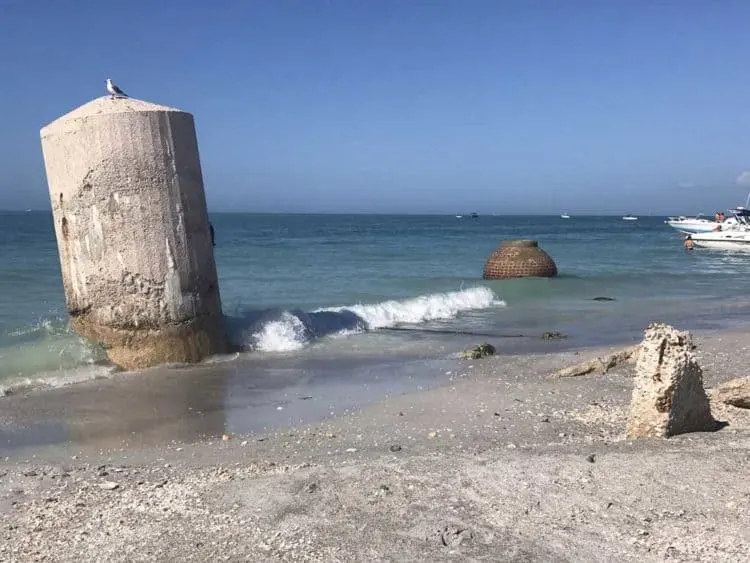
Egmont Key, St. Petersburg
Egmont Key is an island in the mouth of Tampa Bay about 1.6 miles from Fort De Soto Park at the bottom of St. Pete Beach. It is accessible only by ferry or private boat, and thus is not easy or inexpensive to reach.
But if you like visiting crumbling old forts or ghost towns in a jungle, as I do, then Egmont Key makes a splendid adventure.
Egmont Key is preserved as Egmont Key National Wildlife Refuge and is jointly managed with the state, which operates Egmont Key State Park here.
Much of the bayside waterfront and the southern half of the island is off-limits as part of the bird habitat of Egmont Key National Wildlife Refuge. Some 25,000 bird pairs nested on Egmont Key in 2020 with 20,000 of those being laughing gulls. Other species include royal and sandwich terns, brown pelicans, black skimmers, and American oystercatchers.
There are trails here through the ruins of historic Fort Dade, built in 1898 as the Spanish-American War threatened. Gopher tortoises are easily spotted on the trails. The island has lovely beaches and is a good place for a scenic picnic.
Florida Rambler with more on Egmont Key National Wildlife Refuge
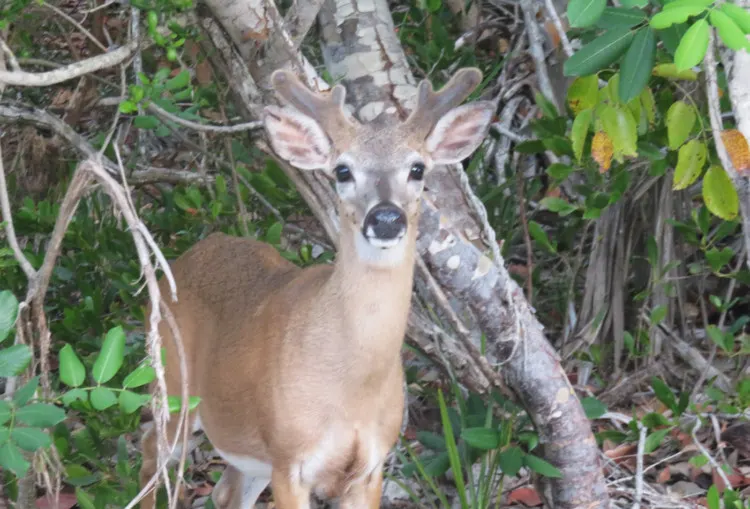
Key Deer/ Florida Keys National Wildlife Refuge, Big Pine Key
As you drive down the Overseas Highway through the Florida Keys, when you are about 45 minutes from Key West you can’t miss the signs saying: Slow down, this is Key deer country.
Well, I advise you don’t just slow down; you should stop – at a free nature center for the Key Deer National Wildlife Refuge. With well-done exhibits and information, the center is staffed with rangers and volunteers equipped to answers visitor questions from what do they eat to where to see Key deer.
Key deer are tiny and rare, with only 600 to 800 remaining. Bucks range from 28 to 32 inches at the shoulder and weigh an average of 80 pounds. Does stand 24 to 28 inches at the shoulder and weigh an average of 65 pounds, according to refuge information. (For comparison, in my home state of Wisconsin, where there are an estimated one million deer, bucks average 150 pounds.)
You can see Key deer anywhere in Big Pine Key and adjoining No Name Key – in yards, along streets, in front of and behind businesses. But the real trick to seeing Key deer is not where to see them but when. Like all white tail deer, they are active at dawn and dusk, and it isn’t hard to spot them at those times.
Whether you spot Key deer here or not (and we did, even at mid-day), we recommend a stroll around the Blue Hole, an abandoned limestone quarry within the Key Deer National Wildlife Refuge. On our visit, a cooperative alligator floated directly below the viewing platform where a volunteer was answering questions.
National Key Deer Refuge Nature Center
30587 Overseas Highway
Big Pine Key, FL 33043
Hours: Monday to Saturday, 10 a.m. to 3 p.m. (Closed Sunday)
Florida Rambler with more on Key Deer/Florida Keys National Wildlife Refuge
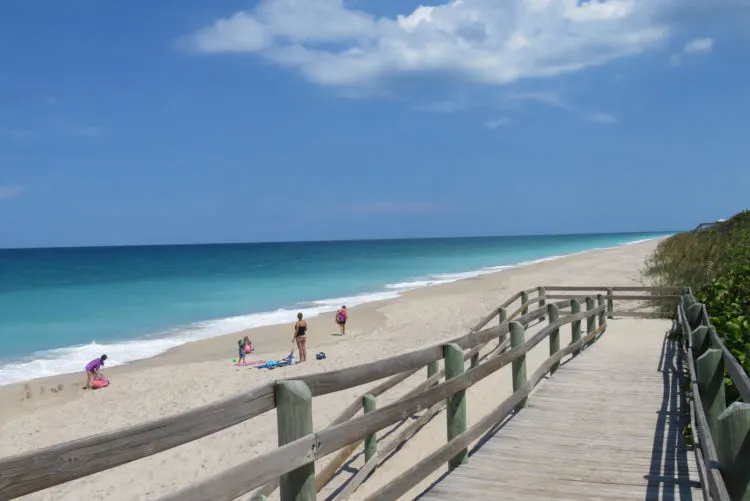
Archie Carr National Wildlife Refuge, Melbourne Beach
Unless you go on a turtle-nesting walk in the summer, the only sea turtles you’re likely to see here are baby ones in tanks, but the beautiful Barrier Island Sanctuary Visitor Center is worth visiting to learn about these fascinating endangered animals. And the view from the boardwalk behind the center is worth appreciating too.
If you like strolling pristine beaches, this is the place for you. The refuge stretches along 20.5 miles of spectacular Atlantic Beach and was established in 1991 to protect loggerhead sea turtles, which nest here by the thousands in summer.
This is a popular place for guided night-time walks to see sea turtles nesting from late May through June.
At other times of year, the beach is popular for swimming, beachcombing and surf fishing. You’ll see pelicans and osprey overhead and sand pipers at the water’s edge.
The visitor center is open Tuesday – Sunday, 9 a.m. – 5 p.m.
Barrier Island Sanctuary Management and Education Center
8385 S. Highway A1A, Melbourne Beach, FL 32951
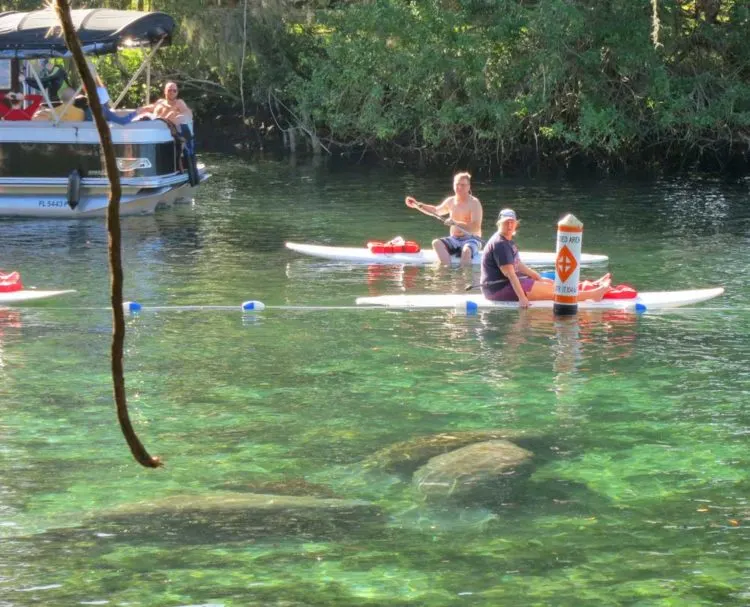
Crystal River National Wildlife Refuge, Crystal River
People flock to Crystal River in the winter to see and swim with manatees. The springs that host these lovable mammals are protected by this wildlife refuge.
A key spot for visitors to Crystal River National Wildlife Refuge is a lovely boardwalk rimming Three Sisters Springs, which provides good views of three gorgeous, interlocked springs and manatees, if any are present. (We visited in November, saw manatees in waters outside the spring, but none in Three Sisters. During cold snaps, there can be hundreds.)
There is no parking at the refuge, however. You must take a trolley and the ticket is a little pricey. In winter, tickets are $20 for adults 13 and older; $17.50 for seniors and $7.50 for children 6 to 13. Even if you walk into the refuge, you must still pay this entrance fee. (Summer rates are $12.50 adults and seniors. Federal Recreation Land passes take $5 off admission.)
Trails around restored wetlands and Lake Crystal are also available, as well as guided walks.
The trolley leaves from the Three Sisters Springs Center, 123 NW US-19, Crystal River, 34428, every 30 minutes.
As an alternative, you can paddle in the waterways around the preserve. Three Sisters Spring is closed to kayaks during manatee season, although many hang out in the waterway leading to the spring and can be easily seen. Our story describes kayak put-in and rental sites.
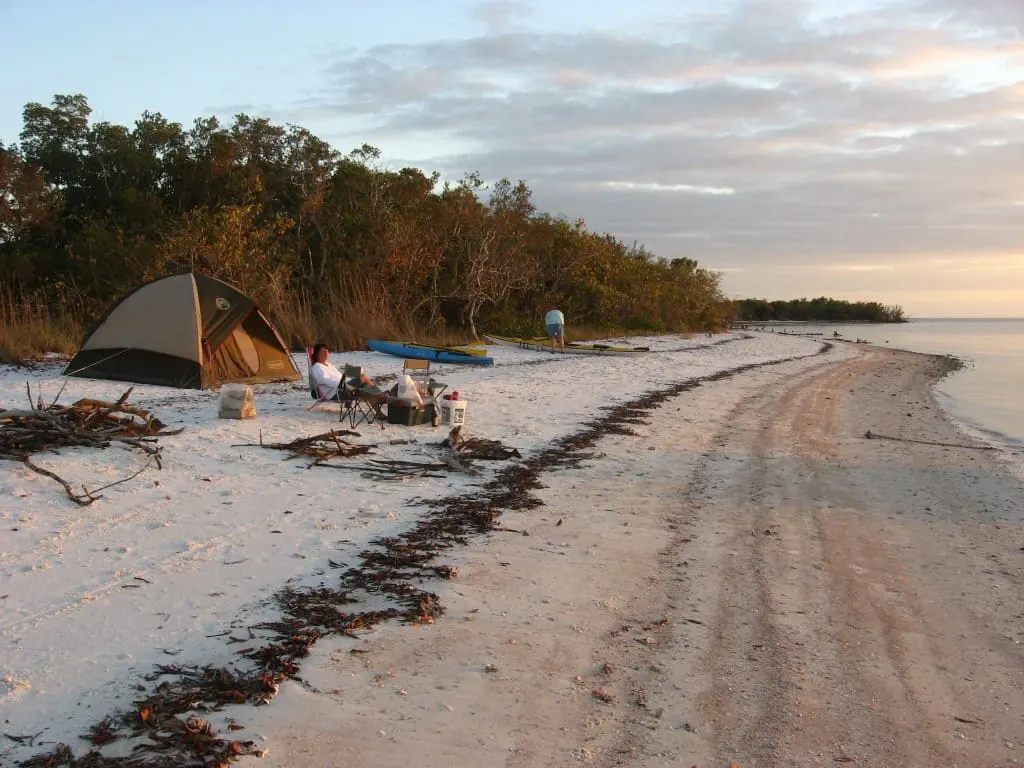
Ten Thousand Islands National Wildlife Refuge
Where the Everglades meet the Gulf Coast, thousands of mangrove islands cluster along the coast, thus the name of this vast wilderness area.
Seeing the Ten Thousand Island National Wildlife Refuge is entwined with seeing the Gulf Coast portion of Everglades National Park.
The area is vast and wild and best seen by boat. In a kayak (yours or rented), you can venture into the mangrove islands on your own.
A favorite adventure of Florida Rambler co-founder Bob Rountree is to paddle into the Ten Thousand Islands and camp on a wilderness island on the beach under the stars. He recounts how to do this — timing the tides and finding your way through the maze of mangroves — in this story on beach camping on Panther Key.
For this kayak trip to Panther Key (or for boat access to Ten Thousand Islands in general), you can leave from Everglades City at the Everglades Visitor Center or from marinas at Port of the Island resort, Goodland/Marco Island or from Collier Seminole State Park.
A shorter trip in the same area does not reach the boundary of the Ten Thousand Island NWR, but takes you into the first group of mangrove islands. This paddle trail within Everglades National Park is about five miles roundtrip to Sandfly Key. There, you can picnic and see vestiges of pioneer homes now long gone. There’s a portapotty too. Here’s Florida Rambler on paddling to Sandfly Key.
The only land-based recreation at Ten Thousand Islands NWR is a trail that often provides good birding. The Marsh Trail and Observation Tower is a 2.2 mile round trip hike along the only access trail on the refuge. The first quarter mile is paved, the rest is a gravel road. A two-story observation tower includes wildlife viewing scopes and benches. Here’s a map of the trail entrance.
Florida Rambler describes five ways to explore the Ten Thousand Islands.
The best base for seeing the Ten Thousand Islands National Wildlife Refuge:
Gulf Coast Visitor Center of Everglades National Park
815 Oyster Bar Lane
Everglades City, FL 34139.
More National Wildlife Refuges in Florida
Here’s a complete list of Florida National Wildlife Refuges.

The author, Bonnie Gross, travels with her husband David Blasco, discovering off-the-beaten path places to hike, kayak, bike, swim and explore. Florida Rambler was founded in 2010 by Bonnie and fellow journalist Bob Rountree, two long-time Florida residents who have spent decades exploring the Florida outdoors. Their articles have been published in the Sun Sentinel, the Miami Herald, the Orlando Sentinel, The Guardian and Visit Florida.
